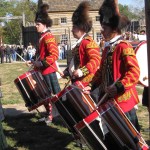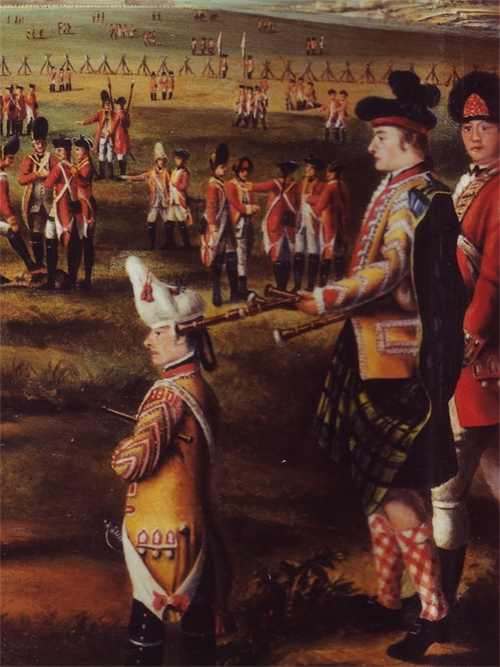The uniforms of pipers is a subject clouded in anecdotes and myths – historians have debated the existence (or not) of pipers in the 18th century Army, what they played (is “pibroch” the same as what it is today?) , what they wore, and how they were accounted for by the Army. Modern pipers have seen the 42nd afield and have chuckled at our “outrageous” get-up, and history buffs have debated our choice of uniforms on the pipers. Here we seek to collect sources for where the 42nd Band’s impression of the pipes, fifes, and drums come from.
Uniforms of the Drummers
It’s impossible to understand the dress worn by the pipers of the 42nd without first addressing the fifers and drummers. The 1768 Clothing Warrant clearly prescribes the dress of drummers and fifers for the time including the 42nd’s service during the Revolution:
The coats of the drummers and fifers of all the royal regiments are to be red, faced and lapelled with blue, and laced with royal lace….. Those of all the other regiments are to be of the colour of the facing of the regiments; faced and lapelled with red.
Here to the left, we see reenactors of non-royal regiments (the 64th and 55th of foot) marching with their drummers. Note the reversed uniforms of the drummers wearing regimentals of black (64th) and green (55th).
Next (below, right) we see the drummers of the 42nd wearing red, lapeled with blue, and the royal musician’s lace. Drummers are wearing the bearskin helmets, per regulations. The fifers would be dressed the same.
No surviving example of the highlander’s short coatee exists. Strachan [1], (pp 180) notes that it was short with red with blue facings, cuffs and cape, or collar. The closest visual source from the period of what this coatee would have looked like is of the piper in the 1771 portrait of Lady Louisa Lennox with the 25th foot at Minorca.
The Minorca Portrait
This brings us to the subject of Lady Lennox’s portrait with the 25th of Foot in Minorca. This portrait is probably the only source that shows both the musician’s short coat as worn by a highlander, and a piper from a regiment from the same time period as the 42nd. The 25th is an ancestor of today’s King’s Own Scottish Borderers and can be seen here wearing coats of yellow (the men of the line wore coats faced with yellow) and red facings per regulations. The regimental lace is the same as the men – white, bordered on each side with thin dark blue/yellow/red lines.
Pipers in the Army
Stories hold that pipers were not officially part of the Scottish regiments until the Victorian era, and were paid out-of-pocket by the Colonel. Certainly, the official existence of pipe bands didn’t begin until that time.
Many sources, however, place pipers in regiments of Scots far before then. Murray’s Music of the Scottish Regiments describes the painting “The Destruction of the Mole at Tangier” – with 4 men playing 3-droned bagpipes with the 1st (Royal) Regiment in 1684. ([5] pp. 49) The 4 pipers are depicted playing together 150 years before the first pipe band. Murray notes some suspicion about the provenance of the pipers in the painting – they look like they don’t quite match the rest of the paining, and wonders if perhaps they were added later. (Update Dec 2012): The Bob Dunsire forums recently discussed this painting.
Murray also notes that Dutch letters raising Scots mercenaries in 1572 mention “pipers” – but that the Dutch word for piper really means “fifer”. The Minorca portrait, though, is visual evidence that pipers marched with a Scottish regiment in the 18th century. There is further written evidence of pipers with Highland regiments:
One of the mutineers in the Black Watch’s 1743 mutiny in London was piper Donald MacDonald.
The 26 May, 1768 inspection return of the 42nd notes:
6 Fifers and 2 Pipers (as Drummers) – 9 Drums …..
[1] (p 267), and a 1759 record discusses the regiment having a piper-major [4], suggesting that there were more than just the two pipers mentioned here.
‘Owen McIntyre pipper in the Grenadier company is appointed pipper major and is this day to receive the clothing accordingly. Peter McIntyre pipper in Capt. Macneil’s company is for the future to be on the posting of a drum and is to be subsisted accordingly’
As well as noting how the pipe major was paid. ([4], pp 11)
“A bank ledger in the possession of the regimental agents, Messrs. Cox & Co., has this entry for 1759 in paymaster Lieutenant Tolmie’s Account: “For the difference of private’s and drummer’s pay to the piper-major, 25th April to 26th December, 1759, 1(Pound) 18s. 10d.”
An inspection on 3rd August, 1774 ([1], pp 267) , reports that the 42nd had
“two Pipers and a very good Band of Music”
Cannon [2] records that a piper was killed in battle in September, 1776, between Long Island and White Plains. Stewart of Garth [7] records that a piper was wounded at Harlem Heights (September 17, 1776). Stewart also notes in a footnote that a piper was killed at Fort Washington:
“One of the pipers, who began to play when he reached the point of a rock on the summit of the hill, was immediately shot, and tumbled from one piece of rock to another til he reached the bottom.”
When transports carrying the 42nd and 71st were captured in 1776, an inventory reported
“…two pair of bag-pipes…” [Naval Docs Providence Gazette, 7/13/76]
The March 28, 1778 muster report for Major Murray’s Company names Robert MacFarland as a piper. [WO 12/5479]. The 9 July, 1776 muster of Alexander Donaldson names “Donald [Morrison?], Piper”
Sections of Muster Rolls usually for “Drummers” read “Drummers and Pipers” in several instances:
- Duncan McPherson’s (line) Company, muster of 30th April 1777
- Charles Graham’s Grenadier Company, muster of 30th April 1777, and 9 July 1776
Captain Peebles [6] records that at a St Andrew’s Day dinner get-together held on Friday 30 November, 1781:
“[after dinner] .. the Band of Musick and the Pipes of the 42nd play’d alternately, & the little Prince being highly pleas’d with the Piper gave him a bumper after every tune.”
The 42nd is not the only regiment with pipers: the 1st (Royal) Regiment of Foot was noted as having pipers in an inspection return dated 14 April, 1772 ([1], pp 203)
The Drum-Major and Pipers’ clothing are returned “wanting”.
A letter dated 6 January 1768 from the Adjutant General to Major General Gage, accounting for arms, accoutrements, and clothing that should go to a Regiment of Foot ([1], p 170) mentioned the piper in the 1st (Royals):
… a Piper and Drum Major are in the establishment to the 1st Battalion of the [1st] Royal Regiment.
As already seen in the Minorca portrait, the 25th had a piper according to an inspection return of 13 May, 1768: ([1], pp 218)
Have a bag-piper in the Band of Music
The 76th Highlanders 1778 inspection of equipment reports: [1], pp 271
Returns include 10 Serjeants’ fusils, 40 halberts, and 2 bagpipes
It is clear that bagpipers were present with many Regiment of Scots in the 18th century, Highland or Lowland, and were on the payrolls, as well as their instruments being on inventory lists.
Dress of the Pipers
So – now we have documentation as to what the drummers of the 42nd wore, what the coats looked like, and found evidence of the “official” existence of the pipers throughout the Army, but how does that lead us to what the pipers wore?
As seen above, Strachan [1] cites an inspection from 1768 that notes that the two pipers and six fifers were uniformed as drummers, which agrees with what the Minorca portrait illustrates. Note the piper in the Minorca portrait is wearing a blue bonnet with a bearskin tuft rather than a bearskin helmet. Owen McIntyre was given the pay of a drummer when made piper-major in 1759. Peter McIntyre’s reassignment to the 42nd’s drummer ranks further suggests that there was potentially some overlap between the pipers and drummers in the 42nd.
Our conclusion, therefore, is that the pipers would be uniformed as a drummer, with a bonnet as worn by the piper of the 25th in Minorca.
An aside about the kilt – the Minorca piper is wearing the Black Watch government tartan, not the Royal Stewart that is worn today by pipers in Scottish Regiments. Not only were the red Royal Stewart kilts currently worn by the 42nd pipers not authorized until the reign of Victoria, but is difficult to envision the Hanoverian King George permitting the Highlanders to use anything even slightly related to the recently vanquished Stuarts.
Other regiments aside from the 42nd may reach a different conclusion:
- The 77th may have worn “Sjt’s quality
scarlet coats, laced with silver and silk lace, and
wearing tasseled bearskin caps with some sort of ornament
on it” - The 78th Frasers of the F&I era may have been dressed as private soldiers.
- Your mileage may vary!
Summary
In conclusion, due to the many sources that note the presence of pipers, inspection returns that indicate that the 42nd’s pipers were dressed as though they were drummers, and a portrait of the 25th regiment’s piper dressed like the regiment’s drummer, we have outfitted all musicians of the 42nd band – whether they be pipers, fifers, and drummers – as ordered for drummers of the period.
References
1: British military uniforms 1768-1796: the dress of the British Army from official sources. Hew Strachan (Arms and Armour Press, 1975)
2: Historical Record of the Forty-Second, or, The Royal Highland Regiment of foot: Containing an account of the formation of six companies of Highlanders in 1729, which were termed “The Black Watch”, and were regimented in 1739; and of the subsequent services of the Regiment to 1844. Richard Cannon (London, 1845)
3: Military Music of the American Revolution. Raoul F Camus (University of North Carolina Press, 1976)
4: REGIMENTAL ROUTINE AND ARMY ADMINISTRATION IN NORTH AMERICA
1759 – Extracts from Company Order Books of the 42nd Royal Highland
Regiment. The Journal of the Society of Army Historical Research, Edited by Colonel R. F. H. Wallace C.M.G. (Vol 30: London, 1952)
5: Music of the Scottish Regiments. David Murray (Edinburgh, 2001)
6: John Peebles’ American War. Ira Gruber (Mechanicsburg, PA, 1998)
7: Sketches of the character, manners, and present state of the Highlanders of Scotland: with details of the military service of the Highland regiments, Volume 1. General David Stewart of Garth (Edinburgh, 1822)





